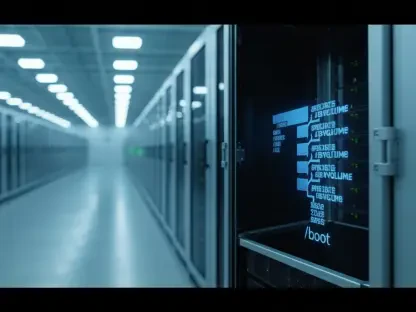Cybersecurity, an ever-evolving domain, represents the practice of protecting individuals, systems, and sensitive data from cyberattacks through an array of sophisticated technologies, policies, and strategies. The rock-solid shield that this field provides is crucial in managing cyber risks, defending against varied threats such as ransomware, malware, phishing scams, data theft, and AI-powered attacks. As threats grow increasingly sophisticated and frequent, the commitment of businesses globally towards enhancing prevention and mitigation is manifest in significant investments. The International Data Corporation has projected that security spending is expected to ascend to a staggering USD 377 billion by 2028, reflecting the pressing demand for robust protection measures.
Trends and Developments in Cybersecurity
Rising Demand and Job Market Expansion
The demand for cybersecurity professionals is witnessing substantial growth, outpacing most other fields. In the United States alone, employment for information security analysts is poised to grow by 32% from 2025 to 2035, fueled by the ever-evolving threat landscape. This increase is notably driven by risks that have the potential to disrupt businesses, communities, and even personal lives, leading to adverse consequences such as identity theft, extortion, and the loss of critical information. As the digital world expands, the prediction that cybercrime could cost the global economy an astronomical USD 10.5 trillion annually by the next two years is a clarion call for intensified focus on safeguarding measures. This anticipated job market expansion underscores the critical nature of remaining vigilant and proactive in cybersecurity efforts to adequately counteract emerging threats.
The modern landscape of cyber threats is constantly shifting as cybercriminals increasingly use new technologies and methods to achieve their goals. The use of cloud computing, a boon for businesses seeking efficiency and innovation, inadvertently expands their attack surface, offering cybercriminals fresh entry points. Similarly, the anonymity provided by the dark web enables sophisticated threat actors, including those backed by nation-states, to acquire cutting-edge tools and resources that enhance their sophistication. Cybercrime’s evolving nature is evident in unprecedented levels of coordination, automation, and skill that accentuate risks from data breaches to substantial disruptions across industries. As businesses integrate more technology, keeping up with these threats requires continuous adaptation and learning.
Economic Implications and Financial Impact
Cyberattacks continue to exert a significant financial toll, with costs rising steadily. IBM’s Cost of a Data Breach Report from recent years highlights a 10% rise in the average cost of data breaches, reaching USD 4.88 million. This increase aligns with the year-over-year escalation in business losses and post-breach response costs, which have climbed by nearly 11%. Compounding this issue, a 22.7% increase in organizations facing regulatory fines exceeding USD 50,000 due to data breaches has been documented, painting a clear picture of the economic repercussions companies face in this realm. The convergence of these factors underscores the importance of strengthened cybersecurity measures and robust response strategies to mitigate financial losses and restore confidence when breaches occur.
Central to the financial ramifications are also key trends that drive cyber threats. The rapidly evolving IT landscape, showcasing emerging technologies, potentially offers significant benefits to businesses and cybercriminals alike. Cloud computing, while immensely advantageous for operational agility and scalability, contributes to network management complexity, increasing risks related to cloud misconfigurations and unsecured APIs. Additionally, distributed work environments, introduced as a necessity during recent global shifts, create numerous connections, devices, applications, and potential entry points for cybersecurity teams to monitor and protect. As a result, organizations must not only heighten their vigilance but also adopt comprehensive security frameworks to guard against a wide array of potential threats.
Challenging the Myths and Addressing the Skills Gap
Dispelling Common Myths in Cybersecurity
In the realm of cybersecurity, several misconceptions persist, hindering the adoption of effective practices and leaving organizations vulnerable. One prevalent myth suggests that strong passwords alone are sufficient to deter cyber threats. However, as attack techniques evolve, relying solely on passwords is no longer adequate for comprehensive protection. Another common misconception is the belief that all significant risks are well-known and adequately managed. In reality, new vulnerabilities emerge regularly, often targeting unforeseen facets of technology infrastructures. Additionally, the myth that only certain sectors face cyber threats further perpetuates a false sense of security, as attackers increasingly target a diverse range of industries, including those traditionally perceived as low-risk, like small businesses.
Dispelling these myths requires a multifaceted approach, focusing on sustained awareness training, advanced security tools, and the implementation of comprehensive identity and access management. For businesses to truly neutralize potential threats, it is crucial to educate employees on identifying potential risks, including phishing attempts and malware attacks, ensuring their active participation in safeguarding measures. Adopting advanced data security tools, such as Data Loss Prevention (DLP) systems, can help prevent sensitive data theft, while encryption serves as a critical guardrail, rendering compromised data useless to malicious actors and providing peace of mind in the event of a breach.
Bridging the Skills Gap with Resources and Innovation
A critical challenge compounding cybersecurity efforts is the glaring skills gap within the industry. This shortfall, identified by the World Economic Forum, highlights a potential deficit of 85 million cybersecurity professionals by 2030. The gap not only affects the ability of organizations to mount an adequate defense but also pushes up the costs associated with security breaches. Companies grappling with significant shortages of skilled personnel report breach costs averaging USD 5.74 million, contrasting starkly with the USD 3.98 million average incurred by organizations with fewer gaps in expertise.
To bridge this chasm, businesses are increasingly leveraging advanced analytics, artificial intelligence, and automated tools to augment their defenses. These technologies play a crucial role in mitigating the effects of human resource shortages, enhancing the ability of cybersecurity teams to detect and respond to threats swiftly and effectively. Attracting and retaining talent in the cybersecurity field is further expedited by fostering partnerships with educational institutions, supporting specialized training programs, and prioritizing continuing education for existing teams. Catalyzing innovation and collaboration within the field promises to create sustainable solutions and secure the digital infrastructures critical to both business operations and daily life.
Comprehensive Cybersecurity Strategies
Building Layered Defenses
Effective cybersecurity measures are characterized by the implementation of comprehensive, multi-layered strategies. These encompass a range of sub-disciplines, including AI security, critical infrastructure protection, network security, endpoint security, application security, and cloud security, each targeting distinct facets of an organization’s IT landscape. In AI security, implementing robust safeguards allows organizations to protect AI systems from external cyberthreats. Such measures are enhanced by AI itself, which plays an integral role in detecting and mitigating risks by analyzing patterns and behaviors indicative of potential cyberattacks.
The protection of critical infrastructure also demands significant attention, ensuring essential societal systems remain secure and functional. Recognized frameworks, such as those from the National Institute of Standards and Technology (NIST) and the Cybersecurity and Infrastructure Security Agency (CISA), guide the implementation of robust measures to safeguard these critical components. Additionally, layered defenses extend to network security, which focuses on preventing unauthorized access and ensuring only authorized users gain entry, enhanced through unified endpoint management solutions that streamline monitoring and intervention efforts.
Leveraging Technological Advancements
Application security is another pillar of cybersecurity, dedicated to identifying, managing, and repairing vulnerabilities within software. By integrating security into the development process through approaches such as DevOps and DevSecOps, organizations can significantly enhance the resilience of their applications against threats. Cloud security, reliant on a shared responsibility model between providers and customers, is integral in ensuring data protection and safe operations in virtual environments. Information security provides additional layers, safeguarding both digital and physical media from unauthorized access, while identity security focuses on protecting digital identities through rigorous verification practices and access control enforcement.
Technological advancements enable security professionals to tackle a variety of today’s most prevalent threats, including malware, ransomware, phishing, credential theft, insider threats, AI-driven attacks, cryptojacking, and Distributed Denial-of-Service (DDoS) attacks. Malware, encompassing harmful software designed to damage systems or users, and ransomware, which holds data hostage, represent significant risks. Phishing techniques deceive users into divulging sensitive information, while credential theft aims to exploit user account controls. Insider threats, whether intentional or accidental, pose a unique challenge, often slipping under the radar until a breach materializes. AI-driven attacks leverage new strategies, such as prompt injection, introducing heightened levels of manipulation and deception for cyber defense teams to combat.
Toward a Secure Digital Future
Cybersecurity is a continuously advancing field centered around safeguarding individuals, computer systems, and sensitive information against cyberattacks. This protection is achieved through a complex blend of advanced technology, comprehensive policies, and strategic frameworks. The robust defense that this sector offers is essential in managing cyber risks and fending off a wide variety of threats, including ransomware, malware, phishing schemes, data breaches, and even AI-driven attacks. As cyber threats become more sophisticated and occur more frequently, businesses worldwide have recognized the necessity of strengthening their prevention and response capabilities. This growing awareness has led to substantial financial investments aimed at enhancing cybersecurity measures. According to the International Data Corporation, it is anticipated that spending on security will reach an impressive USD 377 billion by 2028. This projection underscores the urgent need for dependable and resilient protection systems as cyber threats continue to evolve. In essence, cybersecurity remains a critical priority for organizations striving to safeguard their assets and maintain trust with their clients in an increasingly digital world.









